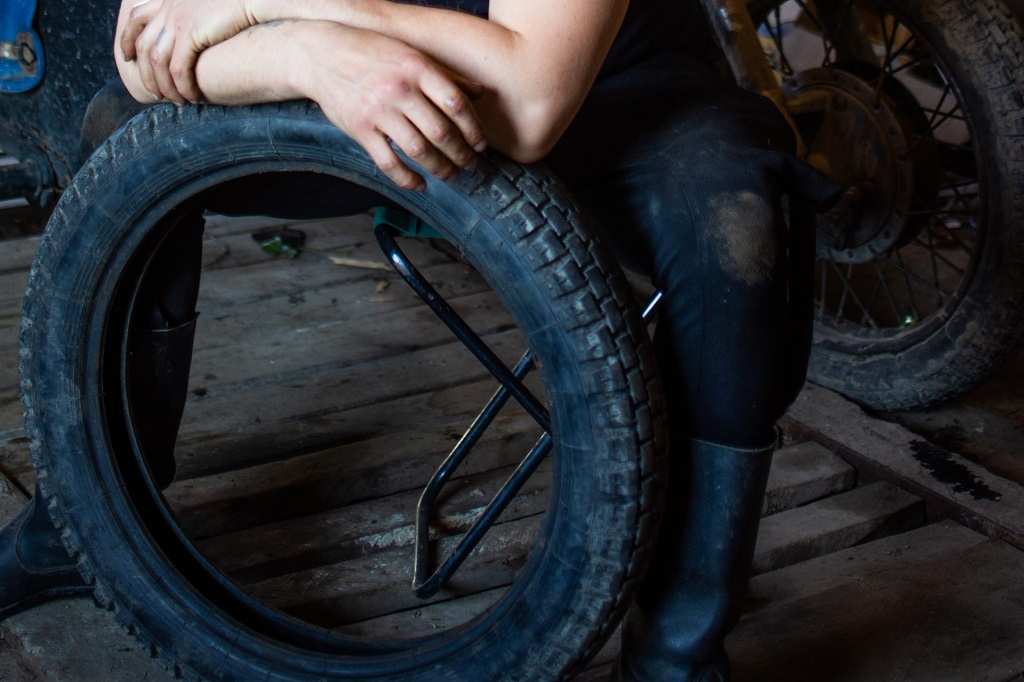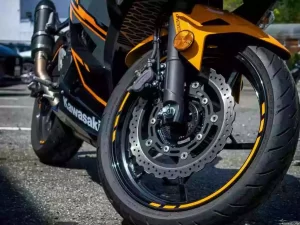As an Amazon Associate, we earn from qualifying purchases. We may get a commission when you purchase through our links, at no extra cost to you.
Many bikers are unsure about when to replace motorcycle tires. Well, there is no specific time frame for tire replacement, but there are some signs that you can look for to tell if it’s time to get new ones. If your motorcycle tires have uneven wear, high tread wear, or a bulge in the sidewall, it’s probably time to replace them. Get a pair of Michelin Pilot Road 4 GT Touring if you want something that lasts longer than regular motorcycle tires.
We bikers love the open road, but a part of being on the open road is maintenance. You have to check your engine oil levels often, and keep an eye on your tire pressure too. Let’s find out how to catch tire wear and the right time to change them.
Jump to the our suggestions for the longest lasting motorcycle tires if you want to cut the talk and get into action!
When to Replace Motorcycle Tires: What’s the Right Time?
When or how often to change tires depends on a number of factors. How much do you ride? How old are the tires? What type of terrain are you in? These questions will help determine how long your motorcycle tires last before they need to be replaced.
Riding rough terrains or riding more than 50 miles per week means your motorcycle tires should be inspected semi-annually, while those who only need their bike for short trips around town have to check them once every two years.
Those who ride on smooth roads can go up to 4 to 5 years before needing new rubber on their wheels.
The age of the tire plays a big factor in how long they last because as it ages, its life span decreases drastically. If you are looking at getting an older used one from someone else, that tire is likely near the end of its life span.
Look for tire wear bars
Apart from the motorcycle tire wear indicator, you should also stay alert for wear indicator bars.
The small, slightly elevated bars are to be found between the tread markings in the grooves. Scattered all across the tires, these bars indicate whether the tread is wearing down evenly or not.
Change the tires before the tread hits these wear bars.
How often should I change my motorcycle tires?
After every four or five years.
The tires may still look “good” after that period. It happens because every rider rides differently which means their mileage will vary. Heavy to light use with high vs low speeds and many other factors play into how quickly your bike wears down its motorcycle tires.
The changing time may vary depending on where you live too. Driving through sand, water, or grass can all wear out the tires much faster than riding straight pavement over long distances. There is no ‘one size fits all’ answer when it comes to replacing them.
How many miles do motorcycle tires last?
When it comes to mileage, the answer depends on the road conditions, your riding habits, and the tire types. A DOT-race type would be toast within 1,000 miles while a sports tire may crank out 5,000 to 6,000 miles.
On the other hand, sport-touring and touring tires can easily survive over 10,000 miles. However, high-quality and high-performance tires can easily exceed 20,000 miles without any problem.
With proper maintenance and avoidance of rough conditions, a decent tire will last between 6,000 and 8,000 miles on average.
Do I need to change both motorcycle tires at once?
No.
If your motorcycle needs new tires, it is not necessary to change both of them. The rear tire tends to wear out faster. Its wider parameter results in a larger contact patch than the front wheel and, therefore, creates a greater risk of punctures. The wear also quickens because of the transmission of power to the rear section.
The best way to know when your tire has reached the end of its lifespan is by checking for signs like uneven wear marks along the side walls or belt edge and changes in tread depth such as cupping at high speeds.
Which Motorcycle Tires Last the Longest Time?
The latest motorcycle tires are a lot better and last longer than they used to be. How long do motorcycle tires last? Well, their durability depends on how you take care of them and the type of tire.
There is no set time in which a motorcycle tire should be changed out to ensure your safety — it all comes down to preference for riders as well.
The longest lasting types are made by Michelin, Metzeler, Bridgestone, and a few other top brands. They also tend to provide better grip n wet surfaces than other brands.

Michelin Pilot Road 4 GT Touring Radial Tire – 180/55R17 73W
KEY FEATURES
- Grip: Reliable on wet surfaces
- Durability: Easily lasts 12k+ miles
The Pilot Road 4 GT is here to change your mind if you’ve never been a big fan of Michelin tires and thought they were overpriced and not worth the hype. You will clearly see the change in performance while testing these tires. Your bike will feel more responsive than ever!
With an increased tread life, the tires offer excellent performance on wet surfaces. Don’t believe that? Just go for a test drive on a day when the weather forecast predicts rain all day.
It may take a while to get used to how quickly my bike would turn on these tires on wet ground. But you will feel like a pro in no time! You can easily crank out around 12,000 miles out of them and even more with the right care and upkeep.
We highly recommend Michelin Pilot Road 4 GT tires for anyone looking for increased performance that rivals Dunlop’s or Federal’s top-of-the-line models (although don’t ask me which one is better). They are worth every penny you will spend.

Metzeler ME888 Marathon Ultra 180/65B16 Rear Tire 2318700
KEY FEATURES
- Seasons: Year Round
- Size: 180/65-16
- Speed Rating: H
- Load Capacity: 1019 Pounds
We recently put some miles on a set of Metzeler ME888 rear tires, and have to say we’re impressed. As riders focusing on long-distance touring, tire durability and predictable handling are top priorities. The ME888 delivers on both fronts in spades.
Right out of the box, we could feel the balanced construction. The stiff carcass provides excellent high-speed stability without sacrificing comfort. On winding backroads, they stuck to the tarmac with confidence-inspiring grip in both dry and wet. Even fully loaded for multi-day trips, we never felt nervous leaning into curves.
After thousands of miles, the tread shows no signs of wear. Metzeler engineered these tires with long-lasting performance in mind through innovations like their symmetric design and special compound. While some tire brands sacrifice characteristics as they age, the ME888s continue to inspire trust at any speed.
About the only minor critique is they tended to accumulate more road grime than previous tires. But a quick wash left them looking nearly new again. It’s a small trade-off for the peace of mind lengthy tread life provides during lengthy tours.
Riders focused on reliability will appreciate these scheduled to go the distance without drama or surprises. The ME888 delivers consistent, balanced handling mile after mile that earns our strong recommendation for anyone seeking a tire that enhances rather than limits their touring experience.

Bridgestone Excedra G851 Cruiser Front Motorcycle Tire 130/70-18
KEY FEATURES
- Grip: Tremendous grip on all terrain
- Durability: Easily lasts 10k+ miles
For those who enjoy riding a large cruiser know that it’s not easy to find a reliable tire to offer great mileage.
Be thrilled because Excedra G851 Cruiser tires offer great service for top-of-the-line V-Rod, Mean Streak, Warrior, and VTX1800C motorcycles. You will get solid performance and with good care, they can easily exceed 10,000 miles.
The tires’ silica enriched compound offers a tremendous level of grip on both wet and dry surfaces.
The tread pattern also enhances the performance with its deep water channels to drain out liquids, as well as its wide grooves that channel away slush and snow for optimal stopping power.
Whether you are an amateur or pro biker, with these tires on, you will feel like home in minutes.
Why Do Motorcycle Tires Wear Faster Than Car Tires?
Because motorcycle tires are softer than car tires.
The rubber in bike tires has to be softer to ensure a bigger and better grip. The typical contact patch between a bike tire and road surface is no bigger than the size of a credit card.
With such a small contact area, the tires have to be softer to get better traction. Hard tires can’t provide such grip and they will most likely slip and slide, making it difficult for bikers to stay on the bike.
Because of having softer rubber, motorcycle tires wear faster than car tires. For this reason, old bike tires don’t have the same level of grip.
What’s the Danger of Not Changing Motorcycle Tires?
Bikers know how crucial having good tires is to their riding. A safe ride on the road is impossible without them.
It’s easy to forget about replacing motorcycle tires and just keep riding them until they blow out. The problem is that once one tire goes, chances are the rest will soon follow suit.
If you want to avoid this happening, take care of your tires more often than not…especially if you’re commuting or going on long trips.
As tires age, their ability to provide traction decreases. If you don’t replace your tires before they’re too old, you’ll be at risk for accidents caused by skidding.
Tires also lose air pressure with time which means less contact with the ground and increased chances of losing control.
To stay safe, pay attention to the wear signs mentioned in the following section.
Motorcycle Tire Wear Indicator: Watch out for the Signs
Replacing worn motorcycle tires is important, so you don’t end up with problems like flat tires and blowouts on the road. How do you know when it’s time? Here are some signs:
Uneven Wear
This is when the tread on a tire is wearing unevenly, usually one side will have more grip than the other. This often leads to wobbling and instability, which can be dangerous while driving.
Damage to the bike’s shocks and struts causes the bike to bounce, affecting its ability to maintain its grip on the road. The bounce itself can also accelerate tire wear, resulting in the tires showing cupping or scalloping (where pieces of rubber are scraped out of the tires).
High Tread Wear
The rubber around your motorcycle tires wears out over time as well, causing less traction between you and the road. The middle part of the tires gets the most contact with the road, so it deteriorates faster than other parts.
If the tread depth reaches below 1/32″, it’s time to start looking for new replacements.
Bulge In Sidewall
A bulge in your wheel could be caused by age or lack of pressure. However, if there’s no visible damage, high chances are that you just need to pump up your tires before they go flat. But changing is necessary in case of a bulge.
Cracking
Ridges or cracks in the sidewall of your tires can be a warning sign that it’s about to go flat and needs replacement.
Despite having tread, a tire can have cracks along the sidewalls (known as dry rot).
Some other concerning signs are wobbling, instability while driving, and excessive tire wear on one side than the other. If you are wondering how often to change motorcycle tires, these symptoms are quite telling.
There is no set mileage to replace your motorcycle tires. Although the rule of thumb is to change them every 5 years, many of them last longer like Michelin Pilot Road 4 GT Touring tires. The important thing is awareness and knowing when they need replacing, so it’s best to pay attention to the wear on them. If you spot a crack, hear an unusual noise, or feel vibration, chances are that it’s time for new ones.
FAQs About When to Replace Motorcycle Tires
Is 12000 miles a lot for a motorcycle tire?
For some tires, yes. However, if you take good care of the tires, avoid rough roads, don’t brake often, they will run well after the 12,000-mile mark. Of course, it varies from one tire to another. Many budget-friendly tires won’t survive beyond 5,000 miles and that is completely fine given the price range.
Are 14 year old motorcycle tires safe?
It depends. Given your maintenance schedule and riding habits, a high-performance tire can still go strong after 14 years. However, to ensure that it does not fail you at a critical moment, look for motorcycle tire wear indicator and wear bars.
Do tires expire if not used?
Yes. According to the National Highway Traffic Safety Administration (NHTSA), a tire usage safety period is 5 to 6 years. But it can last up to 10 years if you can store it in a place free of extreme humidity and temperature.
How old should motorcycle tires be replaced?
Motorcycle tire age is just as important as tread depth. Tires over 6 years old should be replaced due to dry rot and cracking of rubber compounds over time.
What tread depth requires new tires?
When motorcycle tire tread reaches 2/32 of an inch or less, it’s time for replacement. At this point, tire traction is significantly reduced, especially in wet conditions.
Does weather impact tire lifespan?
Yes, extreme weather like heat, heavy rain and snow shorten tire life by breaking down rubber compounds faster. UV light from sunlight also speeds up tire aging.
How much do motorcycle tires typically cost?
Motorcycle tire costs vary widely based on brand, type and size. On average, new tires range from $80 to $400 or more per tire depending on specifications and model.
Do tires need to be balanced after replacement?
Yes, new motorcycle tires should be properly balanced to avoid vibration issues at operating speeds. An out-of-balance tire can also wear out irregularly and shorten life.
What are the symptoms of worn-out tires?
Symptoms of worn-out tires include excessive vibration, uneven wear patterns, reduced handling ability and reduced traction, especially in wet conditions.
Should I get the same brand of tires?
Sticking to the same brand and model of tire is recommended for maximum consistency with the bike’s geometry and specifications. However, different brands with similar specifications will usually perform adequately.




